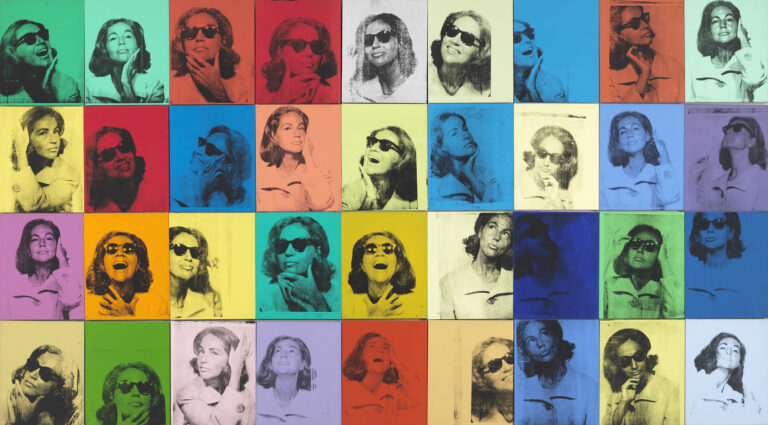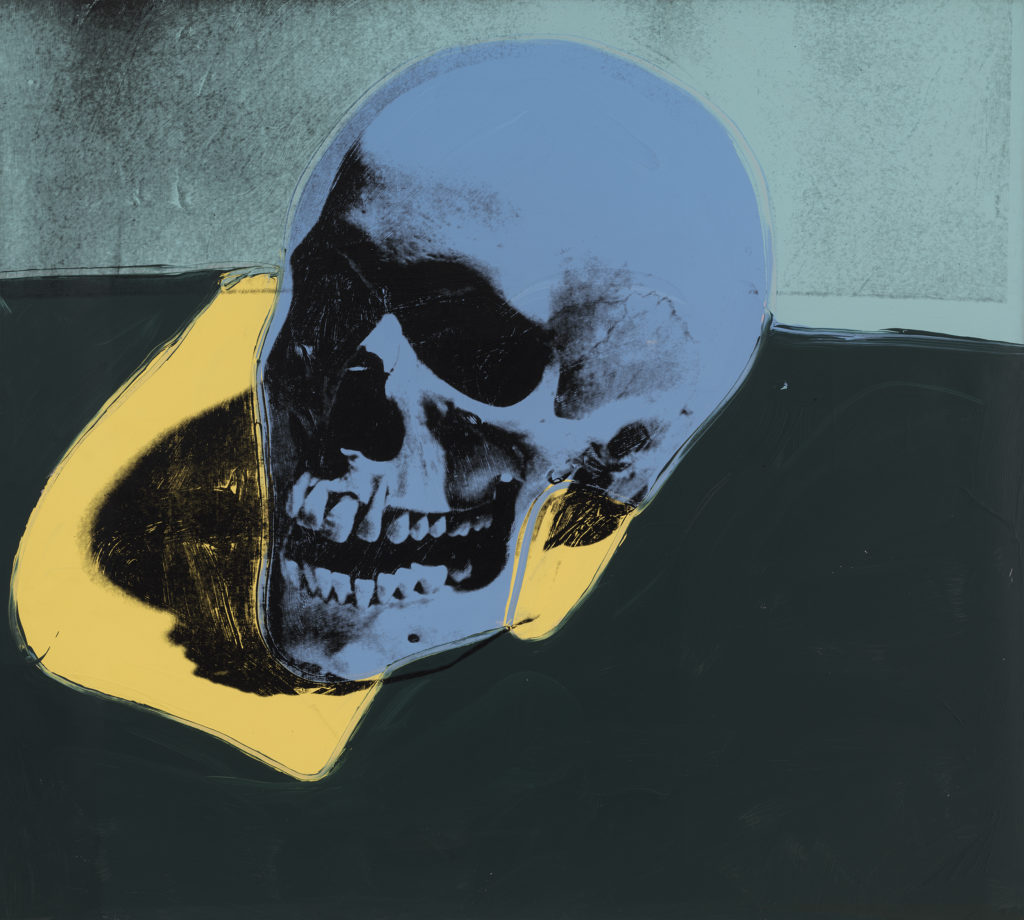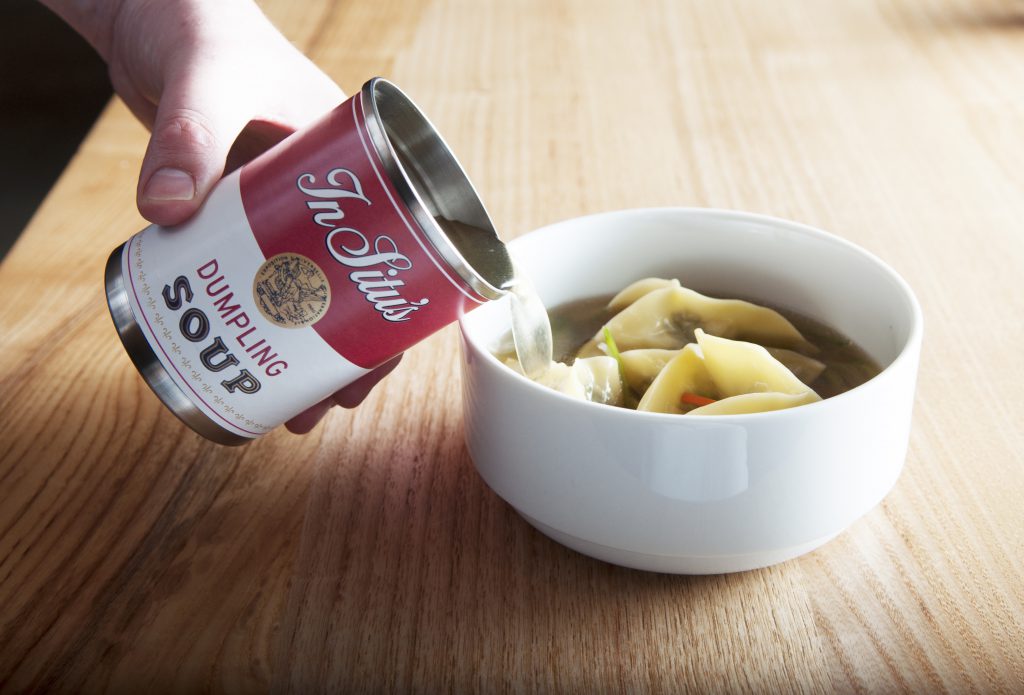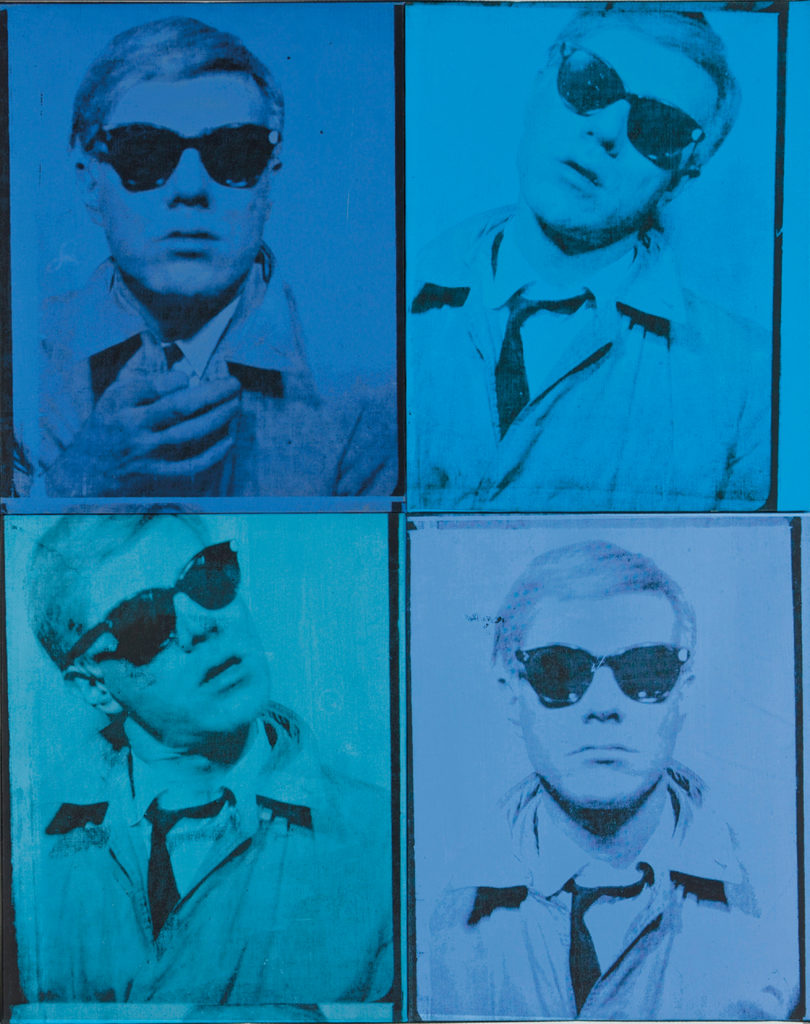
Andy Warhol, Ethel Scull 36 Times, 1963; Whitney Museum of American Art, New York; jointly owned by the Whitney Museum of American Art and The Metropolitan Museum of Art; gift of Ethel Redner Scull; © 2019 The Andy Warhol Foundation for the Visual Arts, Inc. / Artists Rights Society (ARS) New York
SAN FRANCISCO, CA (January 31, 2019) — The San Francisco Museum of Modern Art (SFMOMA) announces the exclusive West Coast presentation of the critically acclaimed exhibition, Andy Warhol—From A to B and Back Again on view from May 19 through September 2, 2019. Spanning the artist’s 40-year career and featuring more than 300 works on three different floors of the museum, the exhibition includes paintings, drawings, graphics, photographs, films, television shows as well as a personal time capsule of ephemera. The retrospective features examples of the artist’s most iconic pieces in addition to lesser-known abstract paintings from later in his career. Uncannily relevant in today’s image-driven world, Andy Warhol—From A to B and Back Again provides new insight into Andy Warhol himself by examining the complexities of this enigmatic artist more than 30 years after his death in 1987. The show’s title is taken from Warhol’s 1975 book, The Philosophy of Andy Warhol (From A to B and Back Again), a memoir featuring the artist’s musings on fame, love, beauty, class, money and other key themes that frequently appear in his work.
“He’s a complicated figure and a complicated artist,” said Gary Garrels, Elise S. Haas Senior Curator of Painting and Sculpture at SFMOMA. “His inner emotions, his psychic self were not his subject matter. Warhol is constantly labeled a Pop artist, but all that happened within three or four years and then he moved on and the work goes quite dark and explores questions of gender and sexual identity, fame, subcultures. At the time of his death, the consensus was that Warhol was no longer relevant. But the last major retrospective in 1989 was a wake-up call: this is an artist we have to reckon with.”
First presented at the Whitney Museum of American Art in New York and curated by Donna De Salvo, Deputy Director for International Initiatives and Senior Curator at the Whitney, with Christie Mitchell, senior curatorial assistant, and Mark Loiacono, curatorial associate, this exhibition provides an opportunity for new generations to reconsider Andy Warhol, one of the most influential, inventive and important American artists. Warhol’s understanding of the growing power of images in contemporary life anticipated our social media-focused world and helped to expand the artist’s role in society making him one of the most recognized artists of the 20th century.
Andy Warhol—From A to B and Back Again also showcases SFMOMA’s impressive holdings of many of the artist’s most important works including National Velvet (1963), Liz #6 (Early Colored Liz) (1963), Triple Elvis (Ferus Type) (1963), Silver Marlon (1963), Robert Mapplethorpe (1983) and several self-portraits.
The Exhibition
Andy Warhol—From A to B and Back Again will be presented on three floors of SFMOMA: two, four and five.
On the museum’s second floor, two galleries of works on paper offer a detailed look at Warhol’s earliest drawings from the 1940s and hand-drawn commercial illustrations created for advertising in the 1950s. These early drawings lay the groundwork for many of the techniques and approaches he would use throughout his career. This portion of the exhibition includes delicate, gilded collages and sketches of shoes for the Miller Shoe Company, and illustrations for publications such as Glamour Magazine and The New York Times, as well as personal, little known drawings, often with homoerotic subjects.
On display in SFMOMA’s fourth-floor special exhibition galleries, the exhibition takes visitors chronologically through the arc of Warhol’s career and his production in painting, drawing, photography, film and installation. The first half of the exhibition opens with his best known work from the creatively active period of 1960–68, with his earliest paintings such as Dick Tracy (1961) and Superman (1961), followed by the groundbreaking, iconic Pop Art paintings, Green Coca-Cola Bottles (1962), 192 One Dollar Bills (1962) and the sculpture, Brillo Boxes (1969, version of 1964 original). The exhibition then highlights Warhol’s depictions of celebrities, including Elvis, Elizabeth Taylor and Jacqueline Kennedy. In a dedicated black box gallery adjacent to the early Pop Art work, samples of Warhol’s films and videos will be on view including his series of Screen Tests featuring Ethel Scull, Edie Sedgwick and Billy Name (1964–65).
Subjects take a darker turn in Warhol’s Death and Disaster paintings (1963–64) memorializing car crashes, the electric chair and a benign yet sinister can of tuna fish contaminated with botulism. An eye-popping gallery filled with 16 colorful Flower paintings (1964) will be installed on top of Warhol’s Cow Wallpaper (1966) for a bold immersive experience. Visitors will have a chance to experience Silver Clouds, Warhol’s sculptural installation of shiny Mylar balloons created in 1966, the point at which he declared himself to be done with painting.

Andy Warhol, Skull, 1976; collection of Larry Gagosian; © 2019 The Andy Warhol Foundation for the Visual Arts, Inc. / Artists Rights Society (ARS) New York
Warhol’s work of the 1970s and 1980s focuses on post-Pop artwork, which Garrels observes are “very unknown to most people.” In these galleries Warhol shifts his focus with a massive portrait of Chairman Mao (1972), followed by a gallery featuring photographs and paintings of trans women and drag queens from the 1970s, which provide a look into Warhol’s fascination with the elusiveness and complexity of gender and identity. A separate suite of photographic self-portraits of Warhol in drag provides a different view into the artist’s carefully cultivated persona. A large single gallery is dedicated to Warhol’s grand experiments with abstract painting, featuring a gold Shadow painting (1978) and two large-scale Rorschach paintings (1984). Warhol’s influence on the young artists of the East Village in the 1980s is highlighted through collaborative works created with Jean-Michel Basquiat and Keith Haring. Also on display is an unpacked personal time capsule, one of 610 created over the course of the artist’s life.
A gallery in the museum’s fifth-floor Pop, Minimal and Figurative Art presentation features a “facebook” of wall-to-wall grids of large-scale silk-screened portraits representing a “who’s who” of celebrities, cultural icons, gallerists, athletes and business leaders from the late 1960s to the mid-1980s. These galleries feature over 40 portraits such as Halston (1975), Dominique de Menil (1969), Liza Minnelli (1978), Pelé (1977), Leo Castelli (1975), Nan Kempner (1973), Gianni Versace (1979–80), Robert Mapplethorpe (1983) and Dolly Parton (1985), as well as the artist’s mother, Julia Warhola (1974). For the subject, a Warhol portrait provided social validation and an immediate status symbol; for Warhol these commissions were a consistent revenue stream that supported his studio and desire to explore other more personal ventures. Warhol’s television shows and videos are on display in the city gallery on this floor.
Warhol Film Program
This summer, SFMOMA will present Andy Warhol’s experimental films exploring queer performativity, celebrity and minimalism/seriality in a film program at the museum in conjunction with the Andy Warhol—From A to B and Back Again exhibition. On view in the museum’s Phyllis Wattis Theater, the series kicks off in June with the eight-hour monolithic work Empire and includes six days of themed programs such as Warhol Goes West, Celebrity and Queer Performativity offering Warhol films from the 1960s. A second film program, Hollywood to Pop! showcases the films whose production stills inspired some of Warhol’s most iconic silkscreen series of Elizabeth Taylor, Marilyn Monroe, Elvis Presley and Marlon Brando, cementing Warhol’s legacy as a chronicler of celebrity.
Thursday, June 27
10 am–9 pm Empire, 1964, 485 min, digital, free with museum admission; screening in the Gina and Stuart Peterson White Box, Floor 4
Double Feature “Warhol Goes West”
6 pm Lonesome Cowboys, 1968, 109 min
8:15 pm San Diego Surf, 1968, 90 min
Friday, June 28 Minimalism and Seriality
1 pm Kiss, 1963, 54 min
2:30 pm Eat, 1964, 39 min
3:30 pm Blow Job, 1964, 41 min
Saturday, June 29 Queer Performativity
1 pm Camp, 1965, 67 min
2:30 pm Vinyl, 1965, 66 min
4 pm My Hustler, 1965, 67 min
Thursday, July 11 The Nude Restaurant
6 pm Eat, 1964, 39 min
7 pm The Nude Restaurant, 1966, 100 min
Saturday, July 13 Celebrity
1 pm Harlot, 1964, 66 min
2:30 pm Hedy, 1966, 67 min
4 pm Lupe, 1965
Sunday, September 1 San Diego Surf and Sunset
1 pm San Diego Surf, 1968, 90 min
3 pm Sunset, 1967, 33 min
4 pm Sunset, 1967, 33 min
All films are in 16mm and all screenings are in SFMOMA’s Phyllis Wattis Theater unless otherwise specified.
Daytime screenings are free and do not require a ticket to the museum. All seating is first come, first served. Thursday evening screenings: $10/members, $12/general public.
HOLLYWOOD TO POP!
Sunday, June 30
1 pm The Wild One, László Benedek, 1953 [inspired Warhol’s Silver Marlon]
3 pm Flaming Star, Don Siegel, 1960 [inspired Warhol’s Triple Elvis (Ferus Type)]
Friday, July 12
1 pm Niagara, Henry Hathaway, 1953 [inspired Warhol’s Marilyn Diptych]
Thursday, August 8
1 pm Butterfield 8, Daniel Mann, 1960 [inspired Warhol’s Liz #6 (Early Colored Liz)]
Tickets: $10/members, $12/general admission. All screenings are in SFMOMA’s Phyllis Wattis Theater.
Spanish Language Exhibition Tours
Ticket holders for Andy Warhol—From A to B and Back Again can participate in new exhibition tours offered in Spanish on the fourth Saturday of every month (May 25, June 22, July 27 and August 24) at 4 pm. Visitors can sign up onsite on the day of the tour. Each tour group will be capped at 25 attendees and will meet at the Information Desk in Schwab Hall on the museum’s second floor. There is no additional charge for the tour. The museum will remain open until 9 pm on Saturdays during the run of the exhibition.

Warhol-Inspired Menu Items at In Situ and Cafe 5
Before or after visiting Andy Warhol—From A to B and Back Again, visitors will be delighted by new Warhol-inspired menu items at the museum’s two dining establishments, In Situ and Cafe 5.
Riffing off of Warhol’s iconic Campbell Soup Cans, In Situ, the museum’s Michelin-starred fine dining restaurant, will offer In Situ’s “Dumpling Soup,” featuring shiitake mushroom and pea leaf dumplings floating in a vegetable broth and served from a distinctive Warhol-inspired soup can. A light, delicious cocktail inspired by Warhol’s Flowers will also be available.
At Cafe 5, the museum’s more casual dining spot on the fifth floor, exhibition-inspired menu items will include The Factory Plate, Edie’s Chicken Salad and Silver Marlon: Rigatoni with Tomato Sauce.

Andy Warhol, Self-Portrait, 1963–64; Cingilli Collection; © 2019 The Andy Warhol Foundation for the Visual Arts, Inc. / Artists Rights Society (ARS) New York
The Artist
Andy Warhol was born Andrew Warhola in Pittsburgh, PA in 1928. In 1949, he graduated from Carnegie Institute of Technology (now Carnegie Mellon University) with a Bachelor of Arts in pictorial design. Shortly after graduation, Warhol moved to New York City, where he would live for the rest of his life, and began what would become a vaunted career as a commercial artist, for which he earned numerous awards and accolades. Despite his commercial success, Warhol was determined to pursue a career as a fine artist. He first exhibited his work at the Hugo Gallery in 1952, though he did not gain recognition in the fine art world until 1962 when the Ferus Gallery in Los Angeles staged his groundbreaking exhibition of Campbell’s Soup Can paintings. Through the 1960s, Warhol exhibited at Ferus, Stable Gallery, Castelli Gallery, Sonnabend Gallery and internationally to great acclaim. He established “the Factory” in 1963, the same year he began his pioneering work in film. In 1965, Warhol announced his “retirement” from painting to pursue filmmaking full-time; underground films such as Empire (1964) and The Chelsea Girls (1966) remain some of his most influential works.
In 1968, Warhol was shot in a near-fatal assassination attempt, but by 1969 he had founded Interview magazine and his interest in producing work across all media — including sculpture, video and performance — was reignited. In 1975, Warhol published The Philosophy of Andy Warhol (From A to B and Back Again) and by the late 1970s had expanded his practice to cable television shows with Andy Warhol’s Fashion, Andy Warhol’s Fifteen Minutes and Andy Warhol’s T.V. Warhol’s work of the late 1970s and 1980s exhibits an increased interest in abstraction and collaboration and often reflexively returns to his own earlier work and iconography. His late work speaks to a voracious interest in current events and enthusiasm for artists from the East Village scene such as Keith Haring and Jean-Michel Basquiat, with whom he collaborated. In February 1987, Warhol died after a brief illness following routine gallbladder surgery. The Andy Warhol Diaries, his infamous account of his own life from the mid-1970s up to his death, was published posthumously in 1991.
Major exhibitions during Warhol’s lifetime include his first institutional solo exhibition at the ICA Philadelphia in 1965, a 1968 exhibition at the Moderna Museet, Stockholm, a 1970 retrospective organized by the Pasadena Art Museum, which traveled extensively and Andy Warhol: Portraits of the 70s organized by the Whitney Museum in 1979–80. The final exhibition of his work during his lifetime, at Robert Miller Gallery, New York, in January 1987, debuted a new series of stitched photographs. Warhol’s work is collected by significant institutions across the world including major repositories at SFMOMA, the Whitney Museum of American Art, Tate, The Museum of Modern Art, The Art Institute of Chicago, The Museum Brandhorst, Munich, The Museum Ludwig, Cologne, The Marx Collection at the Hamburger Bahnhof, Berlin, the National Gallery of Art, Washington, D.C. and the Andy Warhol Museum, Pittsburgh.
Catalogue
The exhibition is accompanied by a full-color, 400-page scholarly monograph edited by Donna De Salvo spanning all periods of Warhol’s career and including paintings, sculpture, drawings, prints, videos, photographs, archival and printed material, installations, films and media works. A contextualizing essay by De Salvo is complemented by essays and contributions from Jessica Beck, Okwui Enwezor, Trevor Fairbrother, Hendrik Folkerts, Bill Horrigan, Bruce Jenkins, Branden W. Joseph, Barbara Kruger, Glenn Ligon, Michael Sanchez and Lynne Tillman, as well as a plate section with 450 images. The catalogue is published by the Whitney and is distributed by Yale University Press.
Other Venues
Whitney Museum of American Art, November 12, 2018–March 31, 2019
The Art Institute of Chicago, October 20, 2019–January 26, 2020
Press Preview
The press preview for Andy Warhol—From A to B and Back Again is Wednesday, May 15, 2019 at 9:30 a.m. at SFMOMA. Please contact press@sfmoma.org for information.
Organization + Support
Andy Warhol—From A to B and Back Again is organized by Donna De Salvo, Deputy Director for International Initiatives and Senior Curator at the Whitney Museum of American Art, with Christie Mitchell, senior curatorial assistant, and Mark Loiacono, curatorial research associate. At SFMOMA, the exhibition is overseen by Gary Garrels, Elise S. Haas Senior Curator of Painting and Sculpture, and Rachel Jans, assistant curator of painting and sculpture.
National leadership support of Andy Warhol—From A to B and Back Again is provided by Kenneth C. Griffin. Bank of America is the National Tour Sponsor. Major support is provided by Doris Fisher, James C. Hormel and Michael P. Nguyen, and SFMOMA’s Collectors’ Forum. Generous support is provided by the Breyer Family Foundation, Roberta and Steve Denning, Mary J. Elmore, Jacqueline Evans, Linda and Jon Gruber, The Hoefer Family, Mary Jo and Dick Kovacevich, Christine and Pierre Lamond, Park L. Loughlin, Sir Deryck and Lady Va Maughan, the Stuart G. Moldaw Public Program and Exhibition Fund, Deborah and Kenneth Novack, the Bernard and Barbro Osher Exhibition Fund, Lisa S. Pritzker, Katie and Amnon Rodan, Arun and Rummi Sarin, Nancy and Alan Schatzberg, Lydia Shorenstein, Dana and Jim Tananbaum, Shannon and Dennis Wong, and Kay Harrigan Woods.
This exhibition is supported by an indemnity from the Federal Council on the Arts and Humanities.
Admission and Summer Hours
May 19 through September 2, 2019: Open Sunday–Tuesday and Friday 10 a.m.–5 p.m., Thursday and Saturday 10 a.m.–9 p.m. Closed Wednesday.
Annual membership for adults begins at $120 and members enjoy free admission to this special exhibition and special preview hours. Visitors aged 18 years and younger receive free admission to the museum, including special exhibitions. The special exhibition Andy Warhol—From A to B and Back Again has a surcharge for all visitors aged 19 and older: $10 weekdays, $12 weekends. Adult general admission to SFMOMA is $25; admission for seniors 65 years and older is $22; and admission for visitors ages 19 through 24 is $19.
Private guided tours and group discounts for Andy Warhol—From A to B and Back Again are available through the SFMOMA Group Sales team. Tours are one hour in length and are not included with museum admission. Tours must be booked at least two weeks in advance. For more information or to submit an inquiry, please visit sfmoma.org/groups.